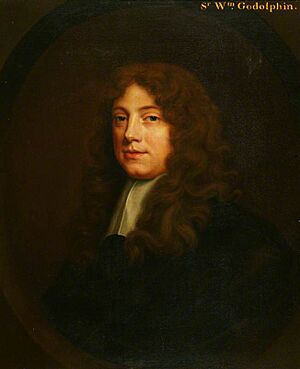William Godolphin (diplomat) facts for kids

Sir William Godolphin (born February 2, 1635 – died July 11, 1696) was an important English diplomat and a Member of Parliament during the time of King Charles II. He served his country in foreign affairs and helped make laws.
Contents
Early Life and Education
William Godolphin was born in Cornwall, England, in 1635. He was the third son of Sir William Godolphin.
He went to Westminster School, a famous school in London. After that, he studied at Christ Church, Oxford, a well-known university. He earned two degrees there: a Master of Arts in 1661 and a Doctor of Civil Law in 1663.
A Career in Politics and Diplomacy
William Godolphin became a supporter of Lord Arlington, a powerful politician. In 1665, Godolphin was chosen to be a Member of Parliament for the area of Camelford. However, he traveled to Spain soon after, so he likely did not serve in Parliament for long.
Working with Other Diplomats
In 1667, Godolphin helped with important talks alongside Lord Sandwich. These talks led to a trade agreement with Spain. This showed his skill in working with other countries.
He was knighted in 1668, which meant he received the title "Sir." In 1669, he was sent to Madrid, the capital of Spain, as a special envoy. He later became the official Ambassador to Spain in 1672.
A Change in Beliefs
Around 1678, people in England began to suspect that Sir William Godolphin had become a Catholic. At that time, England was mostly Protestant, and being Catholic could cause problems. He was called back to England.
However, instead of returning, he openly said he was Catholic. He then decided to stay in Spain for the rest of his life, which was about 20 more years.
Legacy and Schools
Before he passed away, Sir William Godolphin made a special declaration. He allowed his spiritual advisors, including a leader from the Jesuits, to write his will after his death.
In 1697, the English Parliament passed a law to make this unusual will invalid. Instead, his nephew Francis and niece Elizabeth became his heirs. They were given his money on one condition: they had to use £1,520 for charity.
This charitable act eventually led to the creation of two important schools:
- Godolphin and Latymer School in Hammersmith, London.
- Godolphin School in Salisbury.
These schools continue to educate students today, thanks to Sir William Godolphin's legacy.
What Others Thought
Samuel Pepys, a famous writer who met Godolphin in 1668, described him as "a very pretty and able person, a man of very fine parts." This means Pepys thought Godolphin was intelligent and talented.

